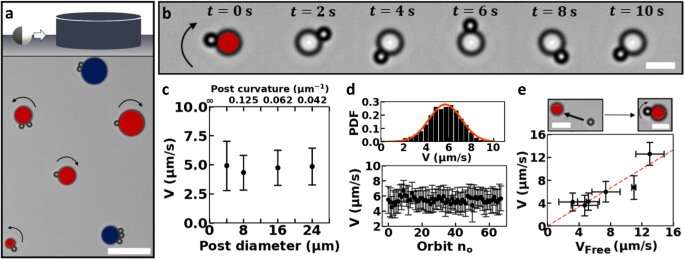Artificial microswimmers work together like bacteria

Microscopic swimmers such as bacteria do not always swim alone. There are advantages to exchanging information and cooperating. Stefania Ketzetzi and colleagues now show in Nature Communications that human-made microswimmers, too, can cooperate.
Cooperative motion lies at the heart of some of the truly complex behavior shown by microorganisms. For example, bacteria cooperate to capture nutrients, cancer cells communicate to accelerate the growth of tumors, and spermatozoa can assemble into trains to move faster toward the egg cell. These collaborations are made possible through the exchange of information between these microorganisms.
Microscopic swimmers made by humans
In the lab, scientists can make similar swimmers. These artificial microswimmers, have become a powerful tool for studying, understanding, and harnessing motion at a microscopic scale. Intriguingly, they as well can work together in the presence of other swimmers or surfaces.
"In our work, we were interested in how artificial microswimmers behave when they encounter specific surfaces," says Ketzetzi, who researched this topic for her Ph.D. at Leiden University. Together with her colleague Melissa Rinaldin, she studied the motion of microscopic spheres near confining surfaces.
Just keep spinning
By partly coating the spheres with platinum and putting them in water with hydrogen peroxide, the spheres will start to move because of a chemical reaction taking place on the platinum side. Ketzetzi: "We then put these self-moving spheres in a container with microscopic 3D-printed posts. When a swimmer comes across one of the posts, it attaches to it and keeps moving around it for a very long time."
This is something that had already been observed by others. But the researchers noticed something interesting when multiple spheres were moving around the same pole: if they moved in the same direction, they worked together to move faster. A collective speed-up just like the collaborations found in nature.
Or, if the swimmers were moving in the opposite direction around the same pole, they stopped each other. A pair of these could remain stationary for a long time, creating a traffic jam for other orbiting swimmers. After a tug of war, the chain would start to move again. But only if there were at least two extra swimmers pushing from one side or the other.
Cooperative motions like these could be relevant in future applications, where artificial swimmers would need to perform tasks while moving within and interacting with a confining environment. Ketzetzi: "In biomedical applications, for example, where artificial microswimmers are expected to play a big role, cooperative behaviors could enable faster drug delivery."
More information: Stefania Ketzetzi et al, Activity-induced interactions and cooperation of artificial microswimmers in one-dimensional environments, Nature Communications (2022). DOI: 10.1038/s41467-022-29430-1
Journal information: Nature Communications
Provided by Leiden University





















